中世纪英语整理
中古英语时期解读
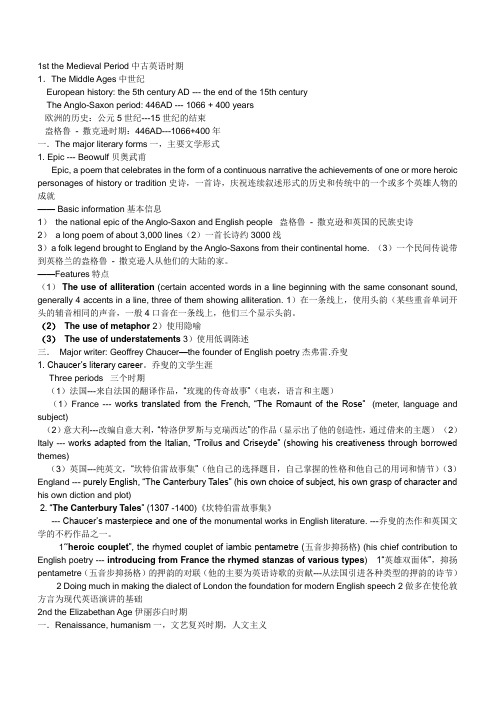
1st the Medieval Period中古英语时期1.The Middle Ages中世纪European history: the 5th century AD --- the end of the 15th centuryThe Anglo-Saxon period: 446AD --- 1066 + 400 years欧洲的历史:公元5世纪---15世纪的结束盎格鲁- 撒克逊时期:446AD---1066+400年一.The major literary forms一,主要文学形式1. Epic --- Beowulf贝奥武甫Epic, a poem that celebrates in the form of a continuous narrative the achievements of one or more heroic personages of history or tradition史诗,一首诗,庆祝连续叙述形式的历史和传统中的一个或多个英雄人物的成就—— Basic information基本信息1)the national epic of the Anglo-Saxon and English people 盎格鲁- 撒克逊和英国的民族史诗2)a long poem of about 3,000 lines(2)一首长诗约3000线3)a folk legend brought to England by the Anglo-Saxons from their continental home. (3)一个民间传说带到英格兰的盎格鲁- 撒克逊人从他们的大陆的家。
——Features特点(1)The use of alliteration (certain accented words in a line beginning with the same consonant sound, generally 4 accents in a line, three of them showing alliteration. 1)在一条线上,使用头韵(某些重音单词开头的辅音相同的声音,一般4口音在一条线上,他们三个显示头韵。
中古英语时期解读

1st the Medieval Period中古英语时期1.The Middle Ages中世纪European history: the 5th century AD --- the end of the 15th centuryThe Anglo-Saxon period: 446AD --- 1066 + 400 years欧洲的历史:公元5世纪---15世纪的结束盎格鲁- 撒克逊时期:446AD---1066+400年一.The major literary forms一,主要文学形式1. Epic --- Beowulf贝奥武甫Epic, a poem that celebrates in the form of a continuous narrative the achievements of one or more heroic personages of history or tradition史诗,一首诗,庆祝连续叙述形式的历史和传统中的一个或多个英雄人物的成就—— Basic information基本信息1)the national epic of the Anglo-Saxon and English people 盎格鲁- 撒克逊和英国的民族史诗2)a long poem of about 3,000 lines(2)一首长诗约3000线3)a folk legend brought to England by the Anglo-Saxons from their continental home. (3)一个民间传说带到英格兰的盎格鲁- 撒克逊人从他们的大陆的家。
——Features特点(1)The use of alliteration (certain accented words in a line beginning with the same consonant sound, generally 4 accents in a line, three of them showing alliteration. 1)在一条线上,使用头韵(某些重音单词开头的辅音相同的声音,一般4口音在一条线上,他们三个显示头韵。
Norman Conquest与中世纪英语
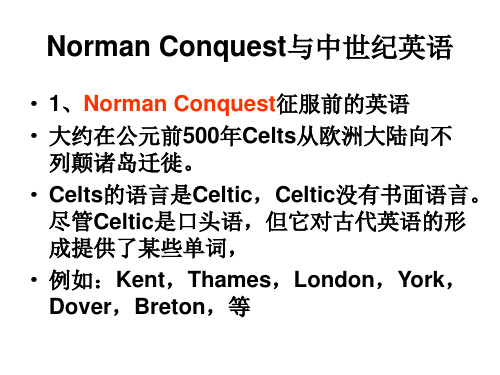
• Norman conquest给英国历史带来了深远 的影响,它使英国和欧洲大陆的关系更为 密切,促进了英国的经济和文化的发展, 也带来了Norman人的生活方式和法国的文 明。 • Norman人所使用的语言是法语的一种方言, 被称为Norman French,是属于拉丁语系 的一种语言,同英语的关系颇远。
• 由于大量的法语词持续不断地涌入,英语 中常有同源异体词(doubles)的现象发生。 因此往往有两个从同一个法语词借入的英 语单词,由于借入的时间不同,结果是: 不同发音、拼写有差别,词义也有所不同, • 如:warden,guardian; • catch,chase; • warranty,guarantee。
• 6)日常生活:dress,dinner,beef,collar, lace,fry,stable,park,forest。 • 7)舒适、排场及奢华为法语;简陋朴素为英语: • Norman French:castle, city, pleasure, chair • English:house,town,gladness,stool • 8)英语:cow,sheep, pig, calf, deer • 法语:beef,mutton,pork,veal,venison • 9)Norman风格的建筑及关于艺术:pillar, palace,tower,art,beauty,design
• 古代英语不是统一的语言,而是一种有明 显方言的语言。古代英语有4种方言,以西 Saxon方言为标准语,Beowulf即为古代英 语诗歌。 • 古代英语每个名词的格多达四种,即主格 (nominative)、对格(accusative)、 所有格(genitive)和与格(dative)。动 词也是凭借屈折形式表示人称、数、时态 及语气等,词尾变化十分繁杂。
第二章:中世纪英语文学
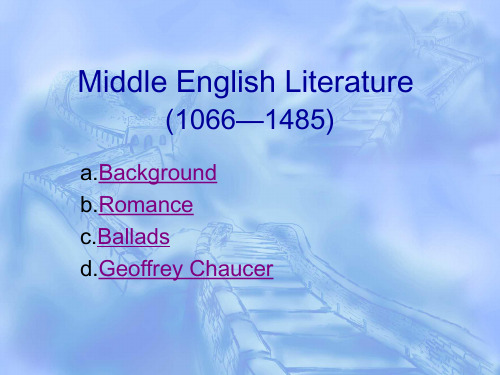
Influence:
Large-scale introduction into England of French culture (French customs and manners), medieval French literature and the literature of Italy and other European countries, as well as the extensive use of the Norman-French language, particularly in the cities and the big manors where the Norman nobility lived. For almost two hundred years after 1066, two languages, native English and Norman-French, existed side by side in England, together with Latin. Latin: religious circle French: upper class and the official language English: lower class/ common people
----- Romance which uses narrative verse or prose to sing knightly adventures or other heroic deeds is a popular literary form in the medieval period. It has developed the characteristic medieval motifs of the quest, the test, the meeting with the evil giant and the encounter with the beautiful beloved. The hero is usu. The knight, who set out a journey to accomplish some missions—to protect the church, to attack infidelity, to rescue a maiden, to meet a challenge, or obey a knightly command. There is an often a liberal use of the improbable, sometimes even supernatural, things in romance such as mysteries and fantasies. Romance love / courtly love is an important part of the plot in romance. ------The Oxford Companion to English Literature, p.842
中世纪 英文简介

The medieval period, commonly referred to as the Middle Ages, spans approximately from the 5th to the late 15th century. This era represents a crucial transitional phase in European history, marked by distinctive cultural, social, and political developments. The medieval period is often divided into three subperiods: the Early Middle Ages, the High Middle Ages, and the Late Middle Ages.### Early Middle Ages (5th to 10th Century):#### **Historical Context:**The Early Middle Ages began with the fall of the Western Roman Empire in 476 AD, a pivotal event that led to the fragmentation of political and social structures. Barbarian invasions, economic decline, and the disintegration of centralized authority characterized this tumultuous period.#### **Feudalism:**Feudalism emerged as a dominant social and economic system during this time. The feudal structure was based on a hierarchical relationship between lords, who owned land, and vassals, who pledged loyalty and military service in exchange for protection. This decentralized system provided a semblance of order in a time of political instability.#### **Role of the Church:**The Catholic Church played a significant role in shaping the social fabric of the Early Middle Ages. Monasteries and convents became centers of learning and culture, preserving classical knowledge and contributing to the spread of Christianity.### High Middle Ages (11th to 13th Century):#### **Economic Revival and Urbanization:**The High Middle Ages witnessed an economic revival, marked by increased agricultural productivity and the growth of trade and commerce. This prosperity contributed to the rise of towns and cities, leading to the development of a nascent urban culture.#### **The Crusades:**The Church's influence extended beyond Europe through the Crusades, a series of religious wars aimed at reclaiming the Holy Land from Muslim control. Although the Crusades had political and economic motivations, they also had profound cultural implications, facilitating the exchange of ideas and goods between the East and West.#### **Scholasticism and Intellectual Revival:**The High Middle Ages saw a resurgence of intellectual activity with the rise of scholasticism. Scholars like Thomas Aquinas sought to reconcile faith and reason, fostering an environment conducive to academic pursuits.#### **Gothic Architecture:**One of the most enduring legacies of the High Middle Ages is the development of Gothic architecture. Cathedrals such as Chartres and Notre-Dame de Paris showcase the innovative use of pointed arches, ribbed vaults, and flying buttresses, reflecting both technological and aesthetic advancements.### Late Middle Ages (14th to 15th Century):#### **Challenges and Crisis:**The Late Middle Ages brought a series of challenges, including the Black Death, a devastating pandemic that swept through Europe and caused significant demographic and economic disruptions. This period also witnessed political instability, social upheavals, and the Hundred Years' War between England and France.#### **Rise of Nation-States:**Amidst the turmoil, the Late Middle Ages saw the emergence of powerful nation-states. Monarchs began to consolidate power, centralize authority, and diminish the influence of feudal lords. This marked a shift toward more centralized forms of governance.#### **Cultural and Artistic Developments:**Despite the challenges, the Late Middle Ages fostered remarkable cultural and artistic achievements. The Renaissance, characterized by renewed interest in classical art and humanism, began to take root, paving the way for the cultural transformations of the following centuries.#### **Decline of Feudalism:**The Late Middle Ages also witnessed the gradual decline of feudalism. Economic changes, technological advancements, and shifts in political power contributed to the erosion of the feudal system, setting the stage for the societal transformations of the Renaissance and the early modern period.### Conclusion:The medieval period, with its distinct phases and multifaceted developments, laid the groundwork for the subsequent evolution of European civilization. From the fragmentation and decentralization of the Early Middle Ages to the economic prosperity and intellectual flourishing of the High Middle Ages, and finally, to the challenges and transformations of the Late Middle Ages, this era was characterized by a complex interplay of social, political, and cultural forces. The legacy of the medieval period endures in the institutions, art, and ideas that shaped the course of European history and influenced subsequent epochs.。
世界古代中世纪史 英语

世界古代中世纪史英语The ancient and medieval history of the world is a vast and complex topic that spans thousands of years and encompasses a wide range of civilizations and cultures. From the ancient empires of Mesopotamia and Egypt to the rise and fall of the Roman Empire and the emergence of the Byzantine Empire, the medieval period saw the development of powerful kingdoms and the spread of influential religious and political ideologies.One of the most significant developments of the ancient and medieval world was the emergence of the great Mesopotamian civilizations, including the Sumerian, Akkadian, Babylonian, and Assyrian empires. These civilizations, located in the region between the Tigris and Euphrates rivers, were among the earliest known human settlements and were responsible for many important technological and cultural advancements. The Sumerians, for example, are credited with the invention of writing, the wheel, and the development of the first known system of mathematics and astronomy.The ancient Egyptians, too, were a highly advanced civilization that left an indelible mark on the ancient world. The Egyptians wereknown for their impressive architectural achievements, such as the pyramids and the Great Sphinx, as well as their sophisticated system of hieroglyphic writing and their advancements in the fields of medicine and engineering. The Egyptian civilization was also deeply influenced by religious beliefs and the worship of numerous gods and goddesses.The rise of the ancient Greek civilization was another significant development in the ancient world. The Greeks were known for their contributions to philosophy, science, and the arts, and their political and cultural influence extended far beyond the boundaries of the Greek peninsula. The Greek city-states, such as Athens and Sparta, were renowned for their military prowess and their democratic and oligarchic forms of government.The Roman Empire, which emerged in the 8th century BCE, was one of the most powerful and influential civilizations of the ancient world. The Romans were known for their impressive military conquests, their sophisticated system of law and governance, and their extensive network of roads and aqueducts. The Roman Empire also played a significant role in the spread of Christianity, which would go on to become one of the dominant religions of the medieval period.The medieval period, which spanned from the 5th to the 15th century CE, was a time of great political, social, and cultural change.The collapse of the Roman Empire in the West led to the emergence of numerous smaller kingdoms and empires, including the Byzantine Empire in the East and the various kingdoms of Europe. The medieval period was also marked by the rise of the Catholic Church and the spread of Christianity throughout Europe and beyond.One of the most significant developments of the medieval period was the feudal system, which was a hierarchical system of social and political organization that dominated much of Europe during this time. Under the feudal system, the land was divided into manors, each of which was controlled by a lord who held power over the peasants and serfs who lived and worked on the land.The medieval period also saw the rise of powerful Islamic empires, such as the Umayyad and Abbasid caliphates, which exerted significant political and cultural influence in the Middle East and North Africa. The Islamic world was also a center of learning and scientific advancement, with scholars making important contributions to fields such as mathematics, astronomy, and medicine.The late medieval period was also marked by the Crusades, a series of military campaigns launched by European Christians against the Muslim-controlled Holy Land. The Crusades had a significant impact on the political and cultural landscape of the medieval world, leadingto increased contact and exchange between the Christian and Islamic worlds.Overall, the ancient and medieval history of the world is a rich and complex tapestry of civilizations, cultures, and political and religious movements that have shaped the course of human history. From the ancient empires of Mesopotamia and Egypt to the powerful kingdoms and empires of the medieval period, this history continues to fascinate and inspire scholars and students alike.。
最新欧洲中世纪英文版(The-middle-age)
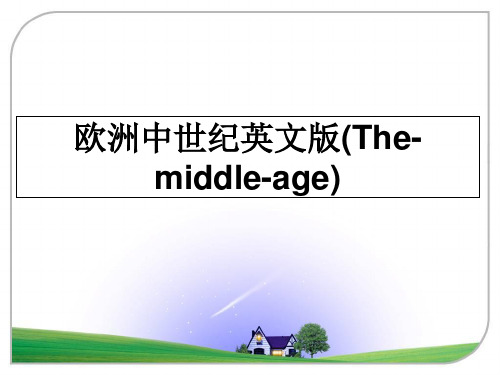
Political and Religion
Feudalism
1. The Manor (封建领主的)领地、庄园
2. Knighthood (骑兵身份)and code of Chivalry( 骑兵制度)
Religion
1. The organization of church
2.The power and influence of the Catholic Church
Gothic art
THE ECONOMY IN MIDDLE AGE
• Nature economy
The economic religion : Mediterranean sea
PEOPLE’S LIFE IN THE MIDDLE AGE
PEOPLE’S LIFE IN THE MIDDLE AGE
欧洲中世纪英文版(Themiddle-age)
General Introduction Political and Religion aspects Culture and Art aspects
People’s life in the Middle Ages
TIME
The fall of the Western Roman Empire The British bourgeois revolution broke out
THE ART AND ECONOMY IN MIDDLE AGES
THE ART IN MIDDLE AGE Byza•nTthienaert oaf rmtiddle aRgeomisabnasneedsoqnureligaiorntto show
the concept of feelings and ideas.
(完整版)中世纪英语整理
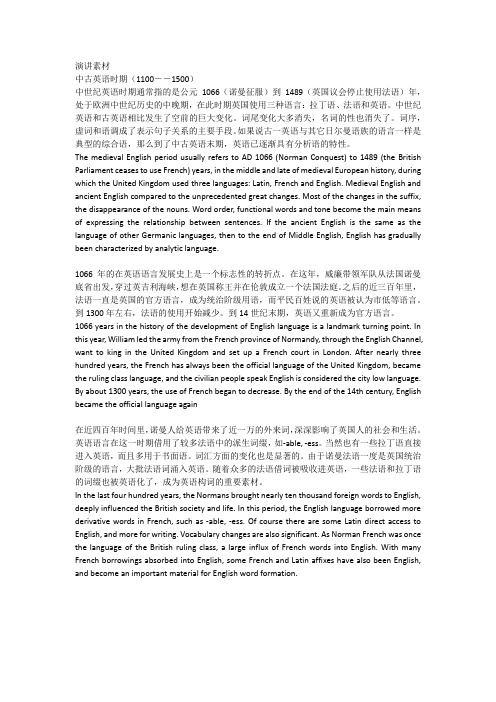
演讲素材中古英语时期(1100――1500)中世纪英语时期通常指的是公元1066(诺曼征服)到1489(英国议会停止使用法语)年,处于欧洲中世纪历史的中晚期,在此时期英国使用三种语言:拉丁语、法语和英语。
中世纪英语和古英语相比发生了空前的巨大变化。
词尾变化大多消失,名词的性也消失了。
词序,虚词和语调成了表示句子关系的主要手段。
如果说古一英语与其它日尔曼语族的语言一样是典型的综合语,那么到了中古英语末期,英语已逐渐具有分析语的特性。
The medieval English period usually refers to AD 1066 (Norman Conquest) to 1489 (the British Parliament ceases to use French) years, in the middle and late of medieval European history, during which the United Kingdom used three languages: Latin, French and English. Medieval English and ancient English compared to the unprecedented great changes. Most of the changes in the suffix, the disappearance of the nouns. Word order, functional words and tone become the main means of expressing the relationship between sentences. If the ancient English is the same as the language of other Germanic languages, then to the end of Middle English, English has gradually been characterized by analytic language.1066年的在英语语言发展史上是一个标志性的转折点。
中古英语名词

中古英语名词古英语(Old English)是指英语早期的一种历史语言形态,通常指公元 5 至 11 世纪英国所使用的英语。
中古英语(Middle English)是指公元 1066 年至公元 1470 年之间的英语,它是中古时期的英语形态。
中古英语作为英语语言进化过程中的一部分,是英语漫长的历史的刻画。
中古英语时期是英国历史上发生了许多重要事件的时期,同时也是英语语言发展过程中最关键的时期之一。
中古英语中传统的名词使用方式、文化与社会的变化及英语的拓展都深刻影响了现代英语的特质。
1. Religion(宗教)中英世纪是英国历史上宗教对人民影响最深的一个阶段,因此,中古英语中出现了很多与宗教有关的名词。
比如:Faith(信仰):指对一个或多个宗教的信仰或信心,例如“faith in God”(对上帝的信仰)。
Heaven (天堂):指天主教和基督教中信仰的天堂。
Church (教堂):指基督教徒聚集的地方,同时也是基督教的标志。
God (上帝):指天主教和基督教中的神,是信仰的中心。
2. Politics(政治)中世纪是英国政治制度逐渐发展的时期,在这期间出现了许多重要的政治名词,例如:King(国王):指君主制中的最高统治者。
Queen(女王):指君主制中国王的妻子或女儿,继承王位时称为女王。
Earl(伯爵):指英国贵族等级制度中的较高等级的爵位。
Baron(男爵):指英国贵族等级制度中的较低等级的爵位。
3. Daily life(日常生活)中古英语时期的日常生活主要以耕种和手工制作为主,因此涉及到了许多与生活相关的名词,例如:Plow(犁):指农村耕种用的工具。
Hammer(锤子):指制作工具时用到的锤形的工具。
Knife(刀):指生产生活中使用的刀具。
Bread(面包):指用面粉制成的食品,是中世纪常见的主食。
4. Education(教育)中世纪的教育主要由宗教机构来完成,主要是古典文化的传承,因此,涉及到了很多与教育相关的名词,例如:Book(书):指用纸或其他材料制成的书籍,是中世纪文化传承的重要媒介。
(完整word版)英美文学知识点总结(适用于英语专八)
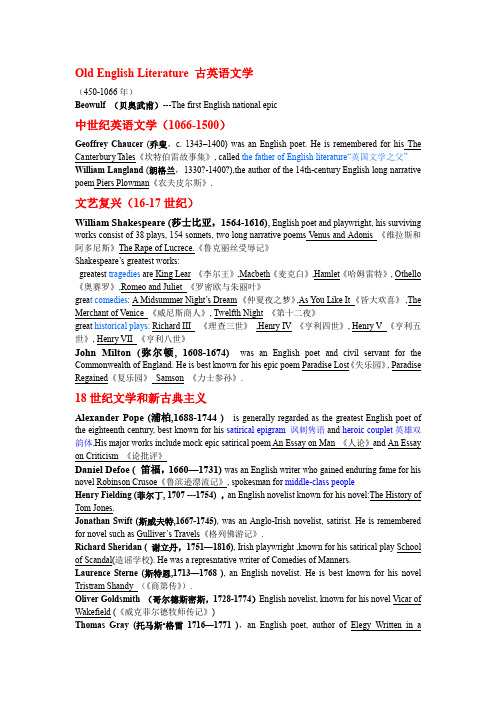
Old English Literature 古英语文学(450-1066年)Beowulf (贝奥武甫)---The first English national epic中世纪英语文学(1066-1500)Geoffrey Chaucer(乔叟,c. 1343–1400) was an English poet. He is remembered for his The Canterbury Tales《坎特伯雷故事集》, called the father of English litera ture“英国文学之父”William Langland (朗格兰,1330?-1400?),the author of the 14th-century English long narrative poem Piers Plowman《农夫皮尔斯》.文艺复兴(16-17世纪)William Shakespeare (莎士比亚,1564-1616), English poet and playwright, his surviving works consist of 38 plays, 154 sonnets, two long narrative poems Venus and Adonis 《维拉斯和阿多尼斯》The Rape of Lucrece.《鲁克丽丝受辱记》Shakespeare’s greatest works:greatest tragedies are King Lear 《李尔王》,Macbeth《麦克白》,Hamlet《哈姆雷特》, Othello 《奥赛罗》,Romeo and Juliet 《罗密欧与朱丽叶》grea t comedies: A Midsumme r Night’s Dream《仲夏夜之梦》,As You Like It 《皆大欢喜》,The Merchant of Venice 《威尼斯商人》, Twelfth Night 《第十二夜》great historical plays: Richard III 《理查三世》,Henry IV 《亨利四世》, Henry V 《亨利五世》, Henry VII 《亨利八世》John Milton (弥尔顿, 1608-1674)was an English poet and civil servant for the Commonwealth of England. He is best known for his epic poem Paradise Lost《失乐园》, Paradise Regained《复乐园》Samson 《力士参孙》.18世纪文学和新古典主义Alexander Pope (浦柏,1688-1744 ) is generally regarded as the greatest English poet of the eighteenth century, best known for his satirical epigram 讽刺隽语and heroic couplet英雄双韵体.His major works include mock epic satirical poem An Essay on Man 《人论》and An Essay on Criticism 《论批评》Daniel Defoe ( 笛福,1660—1731)was an English writer who gained enduring fame for his novel Robinson Crusoe《鲁滨逊漂流记》, spokesman for middle-class peopleHenry Fielding (菲尔丁, 1707 ---1754) ,an English novelist known for his novel:The History of Tom Jones.Jonathan Swift (斯威夫特,1667-1745), was an Anglo-Irish novelist, satirist. He is remembered for novel such as Gulliver’s Travels《格列佛游记》.Richard Sheridan ( 谢立丹,1751—1816), Irish playwright ,known for his satirical play School of Scandal(造谣学校). He was a represntative writer of Comedies of Manners.Laurence Sterne (斯特恩,1713—1768 ), an English novelist. He is best known for his novel Tristram Shandy (《商第传》).Oliver Goldsmith (哥尔德斯密斯,1728-1774)English novelist, known for his novel Vicar of Wakefield (《威克菲尔德牧师传记》)Thomas Gray (托马斯•格雷1716—1771 ),an English poet, author of Elegy Written in aCountry Churchyard(《墓畔哀歌》), writer of sentimentalism感伤派.浪漫主义(18世纪末19世纪初)William Blake (1757 –1827) was an English poet, best known for his poetical collections of Song of Innocence 《天真之歌》and Song of Experience《经验之歌》.William Wordsworth (1770-1850),a major English Romantic poet who, with Samuel Taylor Coleridge, helped launch the Romantic Age in English literature with their 1798 joint publication, Lyrical Ballads《抒情歌谣集》.Wordsworth‘s magnum opus is generally considered to be The Prelude《序曲》.Samuel Taylor Coleridge(柯勒律治, 1772 –1834) was an English poet who was, along with his friend William Wordsworth, one of the founders of the Romantic Movement in England and one of the Lake Poets. He is probably best known for his poems The Rime of the Ancient Mariner《古舟子颂》and Kubla Khan《忽必烈汗》George Gordon Byron (拜伦,1788—1824 )was a English poet and a leading figure in Romanticism.Amongst Byron‘s best-known works are his narrative poems Childe Harold‘s Pilgrimage 《哈罗尔德游记》and Don Juan《唐璜》Percy Bysshe Shelley (1792—1822) was one of the major English Romantic poets and is widely considered to be among the finest lyric poets in the English language. He is perhaps most famous for Ode to the West Wind《西风颂》, To a Skylark《致云雀》, Prometheus Unbound《解放了的普罗米修斯》.Mary Shelley (玛丽• 雪莱1797 –1851) was a British novelist best known for her Gothic novel Frankenstein 《弗兰肯斯坦》, considered as first science fictionJohn Keats ( 济慈, 1795—1821) was an English poet who became one of the principal poets of the English Romantic movement. His masterpieces such as Ode on a Grecian Urn 《希腊古瓮颂》and Ode to a Nightingale《夜莺颂》浪漫主义时期小说家Jane Austen (1775—1817) , was an English novelist. Her major novels include Sense and Sensibility (《理智与情感》), Pride and Prejudice (《傲慢与偏见》), Emma (《爱玛》). Walter Scott (司各特, 1771---1832), a prolific Scottish historical novelist . His major works is Ivanhoe《艾凡赫》Realism 现实主义时期(Victorian Age 维多利亚时期1837-1901)Bronte sisters 勃朗宁姐妹, Charlotte (夏洛蒂, 1816 – 1855), Emily (艾米丽, 1818 – 1848) and Anne (安妮, 1820 – 1849), were English writers of t he 1840s and 1850s. Charlotte‘s Jane Eyre 《简爱》, Emily’s Wuthering Heights 《呼啸山庄》and Anne's Agnes Grey《艾格妮斯·格雷》are masterpieces of English literature.George Elliot (乔治-爱略特,1819—1880 ) was an English novelist. She was one of the leading writers of the Victorian era. Her novels, largely set in provincial England. Her major novels include:The Mill on the Floss《佛洛斯河上的磨坊》Middlemarch《米德尔玛契》.Charles Dickens (1812–1870):one of the most popular English novelists of the Victorian era. His major novels include: A Tale of Two Cities 《双城记》,Oliver Twist 《奥利弗退斯特》,David Copperfield 《大卫科波菲尔德》, Great Expectation 《远大前程》, Hard Times 《艰难时世》William Makepeace Thackeray (萨克雷,1811—1863) was an English novelist of the 19th century. He was famous for his satirical works, particularly Vanity Fair《名利场》Mrs. Gaskell (盖斯凯尔夫人, 1810-1865)was an English novelist during the Victorian era. Her major novels include: Mary Barton 《玛丽• 巴顿》Thomas Hardy(哈代, 1840 – 1928) ,an English novelist of the naturalism自然主义. His major novels include: Tess of the d‘Urbervilles《德伯家的苔丝》Far from the Madding Crowd 《远离尘嚣》Jude the Obscure. 《无名的裘德》Most of his novels are set in Wessex(威塞克斯).现实主义时期诗歌Robert Browning (布朗宁, 1812–1889) was an English poet and playwright whose mastery of dramatic verse, especially dramatic monologues戏剧独白, made him one of the foremost Victorian poets.Alfred Tennyson (丁尼生,1809 – 1892) was Poet Laureate of the United Kingdom and remains one of the most popular English poets. Tennyson excelled at penning short lyrics, including "Break, break, break"Oscar Wilde (王尔德, 1854 – 1900)playwright and one novel, known for his aestheticism唯美主义(art for art’s sake为了艺术而艺术). His major plays include The Importance of Being Earnest《不可儿戏》; His major novel is The Picture of Dorian Gray《道林-格雷的画像》20世纪和现代主义Bernard Shaw (萧伯纳, 1856-1950), an Irish playwright, the greatest dramatist in English literature in the 20th century. He adhered to the tradition of realism, writing plays as a way to discuss social problems. He won Nobel Prize for literature in 1925. His major plays include, Mrs Warren’s Profession《华伦夫人的情人》, Major Barbara《芭芭拉少校》, Pygmalion 《皮革马力翁》and Saint Joan《圣女贞德》John Galsworthy (高尔斯华绥, 1867-1933) one of the most important novelists in the Early 20th century,a Nobel Prize winner. His major works is Forsyte Saga 《福尔赛世家》which comprises three novels:The Man of Property《有产业的人》, In Chancery《衡平法院》To Let 《出租》Joseph Conrad (康拉德, 1857-1932)Conrad was born in Poland and an English novelist. His major novels include Lord Jim 《吉姆爷》and The Heart of Darkness《黑暗的心》.James Joyce (乔伊斯, 1882-1941):An Irish born novelist, known for the technique of the stream of consciousness. His main works: Ulysses 《尤利西斯》;A Portrait of the Artist as a Young Man ; 《青年艺术家的肖像》Finnegan’s Wake; 《芬尼根彻夜祭》Dubliners《都柏林人》E. M. Forster (福斯特, 1879-1970)an English novelist, A Passage to India 《印度之行》T.S. Eliot (T.S.艾略特, 1888-1965):American poet, best known for his poem The Waste Land 《荒原》, 1948 Nobel Prize winner for literature.David Herbert Lawrence (D.H.劳伦斯, 1885-1930),an English novelist. His most important novels are, Rainbow 《彩虹》and Sons and Lovers《儿子与情人》. He is the founder of stream of consciousness意识流.William Butler Yeats (叶芝, 1865-1939)an Irish poet and awarded Nobel Prize for literature in 1923. His major poems include Sailing to Byzantium《驶向拜占庭》and Leda and Swan《利达和天鹅》.Samuel Beckett (贝克特,1906-1989), an Irish dramatist and Nobel Prize winner for Literature. His masterpiece is Waiting for Godot《等待戈多》. He is the exponent of the theatre of the absurd 荒诞派戏剧.Iris Jean Murdoch (默多克, 1919-1999), English female novelist, her major novels include Black Prince《黑王子》, The Sea, the Sea《大海啊,大海》and Unicorn 《独角兽》Doris Lessing (莱辛, 1919--) is a British writer, author of works such as the novels The Grass is Singing. In 2007, Lessing won the Nobel Prize in Literature.Muriel Spark (斯帕克, 1918-2006)English female novelist, best known for her novel The Prime of Miss Jean Brodie (1961) 《布罗迪小姐的青春》Virginia Woolf (伍尔夫, 1882-1941)Woolf is an exponent of modernism and one of the most important female novelists. Her major works include Mrs. Dalloway《达洛威夫人》, To the Lighthouse 《向灯塔去》.美国文学殖民地革命时期Benjamin Franklin (富兰克林, 1706-1790): one of American founding fathers (建国之父) Major works: Autobiography《自传》Poor Richard’s Almanack《穷人理查历书》Jonathan Edwards (爱德华兹,1703 –1758) was a colonial theologian and writer. His work is often associated with the Puritan heritage. His famous sermon "Sinners in the Hands of an Angry God,"《落在忿怒之神手中的罪人》is credited for starting the First Great Awakening.Thomas Pain (潘恩, 1737-1809):British pamphleteer. Major works: Common Sense《常识》(1776)Federalists’ Papers《联邦党人文集》:Alexander Hamilton汉密尔顿John Jay杰伊James Madison曼迪逊浪漫主义时期Romantic Period(1790-1865):Earlier Romantic Period (1790-1830)Romantic Heyday (1830-1865)Earlier Romantic Period:Washington Irving (1783-1859)Fenimore Cooper (1789-1851)Washington Irving (华盛顿• 欧文, 1783-1859):American romantic novelist. He was best known for his short stories “The Legend of Sleepy Hollow” and “Rip Van Winkle”, both of w hich appear in his book The Sketch Book《见闻札记》. Irving is the first American writer who gained international fame.James Fenimore Cooper (库珀, 1789-1851):American romantic novelist , best remembered for his Leatherstocking Tales 《皮袜子故事》(The Pioneer《拓荒者》, Deer Slayer《猎鹿者》, Pathfinder《探路人》, Prairie《大草原》, The Last of the Mohicans《最后的莫西干人》) featuring frontiersman Natty Bumppo.2) Romantic Heyday (1830-1865):Waldo Ralph EmersonHenry David ThoreauWalt WhitmanEmily DickinsonNathaniel HawthorneHerman MelvilleHarriet Beecher StoweEdgar Allan PoeTranscendentalists(超验主义):Waldo Ralph EmersonHenry David ThoreauWalt WhitmanWalt Whitman (惠特曼,1819-1882): American romantic poet, father of free verse(自由诗) , best known for his collection of poems Leaves of Grass 《草叶集》Waldo Ralph Emerson (爱默生,1803-1882): leader of the transcendentalism, his essay Nature 《论自然》is the manifesto of transcendentalism. his another essay The American Scholar《美国学者》is considered to be America's "Intellectual Declaration of Independence”.Henry David Thoreau (梭罗, 1817–1862) : American romantic writer best known for his book Walden《瓦尔登湖》, a reflection upon simple living.Herman Melville (麦尔维尔, 1819–1891) : American novelist, best known for his novel Moby-Dick《白鲸》Nathaniel Hawthorne (霍桑, 1804–1864): American novelist, best known for his four romances(传奇小说):The Scarlet Letter《红字》The House of the Seven Gables 《七个尖尖角的房子》The Blithedale Romance《福谷传奇》The Marble Faun《玉石人像》Emily Dickinson (狄金森,1830–1886) American poetess, whose poetry are concerned with life, death and immortality.Harriet Beecher Stowe (斯托尔夫人, 1811–1896 American female novelist, whose novel Uncle Tom‘s Cabin (1852) 《汤姆叔叔的小屋》attacked the cruelty of slavery.)Realism 现实主义Mark Twain (马克•吐温1835 –1910), American novelist. most noted for his novels The Adventures of Tom Sawyer (《汤姆索亚历险记》)and Adventures of Huckleberry Finn 《哈克贝恩历险记》Life on the Mississippi River《密西西比河上的生活》Connecticut Yankee in King Arthur‘s Court 《亚瑟王朝的康涅狄克州的美国佬》The Gilded Age 《镀金时代》Henry James (亨利•詹姆斯1843-1916), American realist novelist, founder of international novel(国际题材小说)Important works:The American 《美国人》The Europeans 《欧洲人》The Portrait of a Lady 《贵妇画像》The Wings of the Dove 《鸽冀》The Ambassadors 《大使》The Golden Bowl 《金碗》O. Henry 欧亨利was the pen name of American novelist William Sydney Porter (1862 – 1910). O. Henry‘s short stories are well known for his short stories such as Cop and Anthem (《警察和赞美诗》) and Gift of Magie (《麦琪的礼物》)William Dean Howells (豪威尔斯, 1837 –1920) was an American realist novelist and literary critic. Major works include The Rise of Silas Lapham 《赛拉斯• 拉帕姆的发迹》Theodore Dreiser (德莱塞, 1871–1945) American novelist and journalist. He pioneered the naturalist school and is known for his novels Sister Carrie 《嘉莉妹妹》and An American Tragedy 《美国悲剧》and his desire trilogy《欲望三部曲》:The Financier 《金融家》The Titan 《巨头》The Stoic 《斯多葛》American Naturalist (自然主义)1) Stephen Crane 克莱恩2) Frank Norris 诺里斯3) Jack London 杰克-伦敦1) Stephen Crane (克莱恩, 1871–1900) was an American novelist. He won international acclaim for his 1895 Civil War novel The Red Badge of Courage《红色的英勇勋章》.2) Frank Norris (诺瑞斯1870–1902) American novelist. His notable works include McTeague 《麦克提格》, The Octopus《章鱼》3) Jack London (杰克• 伦敦, 1876–1916) American novelist, known for his novel Martin Eden 《马丁• 伊登》, The Call of the Wild 《野性的呼唤》.20世纪和现代主义-诗歌T.S. Eliot (T.S.艾略特, 1888-1965):American poet, best known for his poem The Waste Land 《荒原》, 1948 Nobel Prize winner for literature.Ezra Pound(庞德): American imagist poet意象派诗人, major poems include Cantos 《诗章》, Hugh Selwyn Maubery (莫伯里), Cathay (《华夏》translation of ancient Chinese poems) Robert Frost (弗罗斯特, 1874–1963)American poet. He is highly regarded for his realistic depictions of rural life in New England and his command of American colloquial speech. His work was first recognized in England and then in America.Wallace Stevens(斯蒂文斯, 1879-1955)American poet, best known for his poem Anecdote for the Jar and his emphasis on Imagination.Allen Ginsberg (金斯伯格, 1926-1997), American poet of Beat Generation (垮掉的一代), best known for his poem “Howl”《嚎》Ernest Hemingway (海明威, 1899—1961)American novelist. He was part of the 1920s expatriate community in Paris, and one of the veterans of World War I later known as "the Lost Generation". He received the Nobel Prize in Literature in 1954. Major works:The Sun also Rises 《太阳照样升起》A Farewell to Arms 《永别了-武器》The Old Man and the Sea《老人与海》For Whom the Bell Tolls《丧钟为谁而鸣》“Meditation XVII”, an essay by metaphysical poet John Donne 多恩“any man's death dim inishes me, because I am involved in mankind, and therefore never send to know for whom the bell tolls; it tolls for thee.”Fitzgerald (菲茨杰拉德, 1896–1940) American writer of novels, whose works are evocative of the Jazz Age. Fitzgerald is considered a memb er of the “Lost Generation“. Most important worksis The Great Gatsby 《了不起的盖茨比》which represents the destruction of American dream. Lost Generation迷惘的一代:The 'Lost Generation' is a phrase made popular by American author Ernest Hemingway in his first published novel The Sun Also Rises. Figures identified with the "Lost Generation" include authors and poets Hemingway, F. Scott Fitzgerald, Ezra Pound, Sherwood Anderson, John Dos Passos.William Faulkner 福克纳: American novelist, winner of Nobel Prize for literature. Most of his works was set in an imaginary location named Yoknapatawpha. Major works include:The Sound and the Fury 《喧哗与骚动》Sartoris《家族小说》Go Down, Moses 《去吧,莫西》Light in August 《八月之光》Absalom, Absalom! 《押沙龙,押沙龙!》Sanctuary 《圣地》John Steinbeck (斯坦贝克, 1902–1968) American novelist, Nobel Prize winner. He is known for his novel The Grapes of Wrath《愤怒的葡萄》Saul Bellow(贝缕, 1915-2005)American novelist, Nobel Prize winner, best known for his novel such as The Adventures of Augie March,《奥吉•玛其历险记》Herzog, Seize the Day, Humboldt's GiftJames Baldwin (鲍德温, 1924-1987), black American novelist, best known for his novel Go Tell It on the Mountain 《向苍天呼吁》.Ralph Ellison (艾里森, 1913-1994), black American novelist, best known for his The Invisible Man 《看不见的人》Alex Harley (1936-1969), black American novelist, best known for his Roots 《根》Toni Morrison(莫里森, 1931-)Toni Morrison is a Nobel Prize-winning female American novelist. among the best known are her novels The Bluest Eye《最蓝的眼睛》and Beloved《宠儿》.20世纪戏剧家Eugene O‘Neil (尤金-奥尼尔, 1888-1953)American playwright, Nobel Prize winner, best known for his Long Day’s Journey Into Night《长夜漫漫路迢迢》, Beyond the Horizon 《天边外》,The Hairy Ape 《毛猿》Arthur Miller (亚瑟-米勒,1915-2005 ), American playwright, best known for his The Death of Salesman《推销员之死》Edward Albee (阿尔比1928---) is an American playwright best known for Who‘s Afraid of Virginia Woolf?(《谁怕弗吉尼亚伍尔夫》). His early works reflect a Americanization of the Theatre of the Absurd 荒诞派that found its peak in works by Irish playwrights such as Samuel Beckett贝克特.。
欧洲中世纪英文版(The-middle-age)
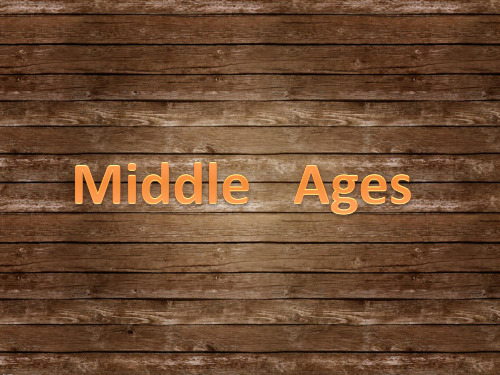
2. Knighthood and code of Chivalry
Almost all nobles in the Medieval days were knights Code of Chivalry: As a knight, he was pledged to protect the weak, to fight for the church, to be loyal to his lord and respect woman of noble birth.
Political and Religion
Feudalism
1. The Manor (封建领主的)领地、庄园
2. Knighthood (骑兵身份)and code of Chivalry( 骑兵制度)
Religion
1. The organization of church
2.The power and influence of the Catholic Church
Middle Ages is also called “Dark Ages”,
because after Uncivilized Germanics conquered the Rome, they made both people’s living standard and spiritual standard drop to a very low point. That’s a kind of “countermarch of civilization
• many people went on journeys to sacred places to express their religious feelings.
中古英语名词

中古英语名词1. Renaissance (文艺复兴): A period of great cultural and artistic change in Europe from the 14th to the 17th century. It saw the revival of interest in classical learning, a growth in scientific exploration, and innovations in art, music, and literature.2. Industrial Revolution (工业革命): A period of major social, economic, and technological change that began in Britain in the late 18th century and spread throughout the world. It saw the development of new manufacturing processes, the growth of cities and factories, and changes in transportation, communication, and agriculture.3. Enlightenment (启蒙运动): A philosophical and intellectual movement in Europe during the 18th century that emphasized reason, individualism, and liberty. It sought to challenge traditional authority and promote scientific inquiry and human progress.4. Romanticism (浪漫主义): An artistic, literary, and intellectual movement that emerged in Europe in the late 18th and early 19th centuries. It emphasized emotion, imagination, and individualism, and celebrated nature, the supernatural, and the exotic.5. Imperialism (帝国主义): A policy or practice of extending a country's power and influence through colonization, use of military force, or economic domination. It was prevalent in the 19th and early 20th centuries as European powers sought to expand their empires and exert control over other regions and peoples.6. Modernism (现代主义): An artistic and literary movement that emerged in the late 19th and early 20th centuries in response to the changing social, cultural, and technological landscape. It emphasized experimentation, abstraction, and the rejection of traditional forms and conventions.7. Civil Rights Movement (公民权利运动): A social and political movement in the United States during the 1950s and 1960s that aimed to end racial discrimination and segregation against African Americans. It was characterized by nonviolent protests, civil disobedience, and legal challenges to unjust laws and practices.8. Feminism (女权主义): A social and political movement that advocates for gender equality and women's rights. It emerged in the 19th century and has continued to evolve and expand in the20th and 21st centuries, promoting issues such as reproductive rights, equal pay, and representation in leadership positions.9. Globalization (全球化): A process of increasing interconnectedness and interdependence among people, businesses, and nations around the world. It has been facilitated by advances in technology, transportation, and communication, and has had both positive and negative effects on economic growth, cultural exchange, and political power dynamics.10. Climate Change (气候变化): A long-term shift in weather patterns and global temperatures caused by the accumulation of greenhouse gases in the atmosphere. It is a significant global challenge that threatens the environment, public health, and theeconomy, and requires collective action at local, national, and international levels to mitigate and adapt to its impacts.。
欧洲中世纪英语

欧洲中世纪英语The European Middle Ages: A Time of Language TransformationDuring the Middle Ages, the European continent experienced a period of significant linguistic and cultural evolution. The English language, in particular, underwent a remarkable transformation, reflecting the complex political, social, and religious changes that swept through the region.The origins of the English language can be traced back to the Germanic tribes that settled in Britain following the withdrawal of the Roman Empire in the 5th century. These tribes, including the Angles, Saxons, and Jutes, brought with them their own dialects, which eventually coalesced into what is now known as Old English. This early form of the language was heavily influenced by the languages of the invading groups, as well as the remnants of the Britons, who had inhabited the islands before the arrival of the Germanic settlers.The introduction of Christianity to the British Isles in the 6th century played a crucial role in the development of the English language. The arrival of Christian missionaries, such as Saint Augustine, brought with them a new set of vocabulary and concepts, which weregradually incorporated into the existing linguistic framework. This influx of religious terminology, coupled with the increasing use of Latin in ecclesiastical and scholarly circles, helped to shape the evolution of Old English.As the centuries passed, the English language continued to evolve, reflecting the dynamic political and social landscape of the European Middle Ages. The Norman Conquest of 1066, led by William the Conqueror, had a profound impact on the language. The influx of French vocabulary and grammatical structures into the English language, as a result of the Norman influence, led to the development of Middle English.Middle English, which was spoken from the 11th to the 15th century, was a complex and diverse linguistic form, with regional dialects and variations. This period saw the emergence of some of the most renowned literary works in the English language, such as Geoffrey Chaucer's "The Canterbury Tales," which showcased the richness and versatility of the language.During the Middle Ages, the English language also played a crucial role in the dissemination of knowledge and the preservation of cultural heritage. The translation of religious texts, such as the Bible, into the vernacular languages, including English, helped to make these important works accessible to a wider audience. Additionally,the development of educational institutions, such as universities, contributed to the standardization and codification of the language, as scholars and scribes worked to establish a more uniform system of grammar and orthography.Moreover, the Middle Ages witnessed the emergence of a vibrant literary tradition in the English language. Writers and poets, such as William Langland and the anonymous author of "Beowulf," explored a wide range of themes, from religious devotion to heroic tales, using the evolving language as a powerful tool of expression.The linguistic diversity and dynamism of the European Middle Ages were not limited to the English language alone. Other languages, such as French, German, and Italian, also underwent significant transformations during this period, reflecting the broader cultural and political changes that swept through the continent.In conclusion, the European Middle Ages were a formative era in the evolution of the English language. The complex interplay of political, social, and religious forces, combined with the influx of foreign linguistic influences, contributed to the remarkable transformation of the language, laying the foundation for its eventual rise as a global lingua franca. The rich literary and cultural heritage of this period continues to shape our understanding of the English language and its enduring significance in the context of European history.。
01、古英语文学和中世纪文学
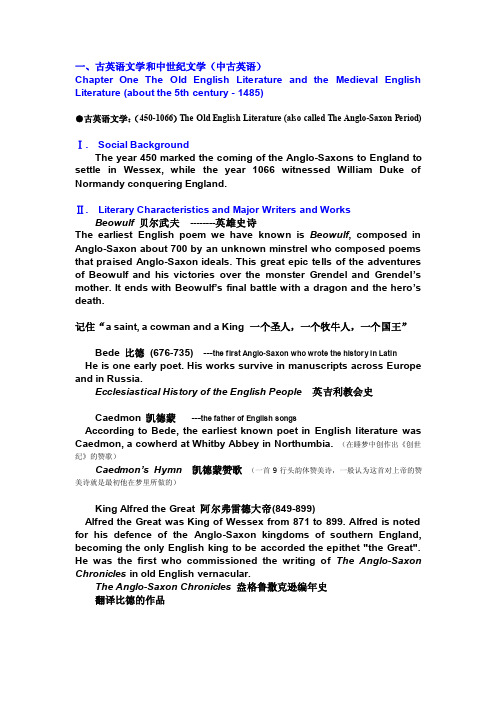
一、古英语文学和中世纪文学(中古英语)Chapter One The Old English Literature and the Medieval English Literature (about the 5th century - 1485)●古英语文学:(450-1066)The Old English Literature (also called The Anglo-Saxon Period)Ⅰ. Social BackgroundThe year 450 marked the coming of the Anglo-Saxons to England to settle in Wessex, while the year 1066 witnessed William Duke of Normandy conquering England.Ⅱ. Literary Characteristics and Major Writers and WorksBeowulf 贝尔武夫--------英雄史诗The earliest English poem we have known is Beowulf, composed in Anglo-Saxon about 700 by an unknown minstrel who composed poems that praised Anglo-Saxon ideals. This great epic tells of the adventures of Beowulf and his victories over the monster Grendel and Grendel’s mother. It ends with Beowulf’s final battle with a dragon and the hero’s death.记住“a saint, a cowman and a King 一个圣人,一个牧牛人,一个国王”Bede 比德(676-735) ---the first Anglo-Saxon who wrote the history in LatinHe is one early poet. His works survive in manuscripts across Europe and in Russia.Ecclesiastical History of the English People 英吉利教会史Caedmon 凯德蒙---the father of English songsAccording to Bede, the earliest known poet in English literature was Caedmon, a cowherd at Whitby Abbey in Northumbia. (在睡梦中创作出《创世纪》的赞歌)Caedmon’s Hymn 凯德蒙赞歌(一首9行头韵体赞美诗,一般认为这首对上帝的赞美诗就是最初他在梦里所做的)King Alfred the Great 阿尔弗雷德大帝(849-899)Alfred the Great was King of Wessex from 871 to 899. Alfred is noted for his defence of the Anglo-Saxon kingdoms of southern England, becoming the only English king to be accorded the epithet "the Great". He was the first who commissioned the writing of The Anglo-Saxon Chronicles in old English vernacular.The Anglo-Saxon Chronicles 盎格鲁撒克逊编年史翻译比德的作品●中世纪文学:(1066-1485)The Medieval English LiteratureⅠ. Social BackgroundMiddle English literature refers to the literature in the period from Norman Conquest to the end of the Wars of the Roses and the accession of Henry Ⅶ. The evolution of something new is most apparent in some of the developments in religious writing in Middle English literature. The literature was various and deeply influenced by French.Ⅱ. Literary Characteristics and Major Writers and WorksTwo main literature forms:Medieval Romance (浪漫传奇:原本指中世纪早期地中海沿岸西部地区的一种用诺曼语讲述的故事。
中世纪风英语达芬奇介绍

MEDICIAL
(医学)
dissecting the cadavers of criminals(解剖罪犯的尸体) under inhuman, disgusting conditions which normal people can't stand it.
Leonardo da Vinci promotes the development of anatomy(解剖学)
Leonardo Da Vinci
Far More Than a Great Artist
英
语
演
讲
20XX.演讲者:XX
1452.4.151519.5.2
Leonardo da Vinci (达芬奇)
14/15 April 1452 – 2 May 1519 known as Leonardo da Vinci was an Italian polymath of the Renaissance whose areas of interest included science and invention, drawing, painting, sculpture, architecture, music, mathematics, engineering, literature, anatomy, geology, astronomy, botany, paleontology, and cartography. He has been variously called the father of palaeontology, ichnology, and architecture, and is widely considered one of the greatest painters of all time (despite perhaps only 15 of his paintings having survived)
- 1、下载文档前请自行甄别文档内容的完整性,平台不提供额外的编辑、内容补充、找答案等附加服务。
- 2、"仅部分预览"的文档,不可在线预览部分如存在完整性等问题,可反馈申请退款(可完整预览的文档不适用该条件!)。
- 3、如文档侵犯您的权益,请联系客服反馈,我们会尽快为您处理(人工客服工作时间:9:00-18:30)。
演讲素材
中古英语时期(1100――1500)
中世纪英语时期通常指的是公元1066(诺曼征服)到1489(英国议会停止使用法语)年,处于欧洲中世纪历史的中晚期,在此时期英国使用三种语言:拉丁语、法语和英语。
中世纪英语和古英语相比发生了空前的巨大变化。
词尾变化大多消失,名词的性也消失了。
词序,虚词和语调成了表示句子关系的主要手段。
如果说古一英语与其它日尔曼语族的语言一样是典型的综合语,那么到了中古英语末期,英语已逐渐具有分析语的特性。
The medieval English period usually refers to AD 1066 (Norman Conquest) to 1489 (the British Parliament ceases to use French) years, in the middle and late of medieval European history, during which the United Kingdom used three languages: Latin, French and English. Medieval English and ancient English compared to the unprecedented great changes. Most of the changes in the suffix, the disappearance of the nouns. Word order, functional words and tone become the main means of expressing the relationship between sentences. If the ancient English is the same as the language of other Germanic languages, then to the end of Middle English, English has gradually been characterized by analytic language.
1066年的在英语语言发展史上是一个标志性的转折点。
在这年,威廉带领军队从法国诺曼底省出发,穿过英吉利海峡,想在英国称王并在伦敦成立一个法国法庭。
之后的近三百年里,法语一直是英国的官方语言,成为统治阶级用语,而平民百姓说的英语被认为市低等语言。
到1300年左右,法语的使用开始减少。
到14世纪末期,英语又重新成为官方语言。
1066 years in the history of the development of English language is a landmark turning point. In this year, William led the army from the French province of Normandy, through the English Channel, want to king in the United Kingdom and set up a French court in London. After nearly three hundred years, the French has always been the official language of the United Kingdom, became the ruling class language, and the civilian people speak English is considered the city low language. By about 1300 years, the use of French began to decrease. By the end of the 14th century, English became the official language again
在近四百年时间里,诺曼人给英语带来了近一万的外来词,深深影响了英国人的社会和生活。
英语语言在这一时期借用了较多法语中的派生词缀,如-able, -ess。
当然也有一些拉丁语直接进入英语,而且多用于书面语。
词汇方面的变化也是显着的。
由于诺曼法语一度是英国统治阶级的语言,大批法语词涌入英语。
随着众多的法语借词被吸收进英语,一些法语和拉丁语的词缀也被英语化了,成为英语构词的重要素材。
In the last four hundred years, the Normans brought nearly ten thousand foreign words to English, deeply influenced the British society and life. In this period, the English language borrowed more derivative words in French, such as -able, -ess. Of course there are some Latin direct access to English, and more for writing. Vocabulary changes are also significant. As Norman French was once the language of the British ruling class, a large influx of French words into English. With many French borrowings absorbed into English, some French and Latin affixes have also been English, and become an important material for English word formation.
到中古英语末期,英语已经确立了作为英国国语的地位。
乔叟的作品证明,英语已成为一种成熟的文学语言。
英语语法的简单化过程已大体完成,拼写走向固定,基本词汇也已形成。
总之,现代英语的基础也已经奠定。
如果说阅读中古英语以前的英语仿佛是在读另外一种语言,那么十六世纪以后的英语与当代的英语的差别也就不那么明显了。
对英语拼写标准化、传播英语书面语都起了很大的推进作用。
At the end of Middle English, English has established its status as a British language. Chaucer's work proves that English has become a mature literary language. English grammar simplification process has been largely completed, spelling to fixed, the basic vocabulary has also been formed. In short, the foundation of modern English has also been laid. If you read English in Middle English as if you were reading another language, then the difference between English and contemporary English after the sixteenth century was not so obvious. The English spelling standardization, the dissemination of English written language has played a great role in promoting.。
